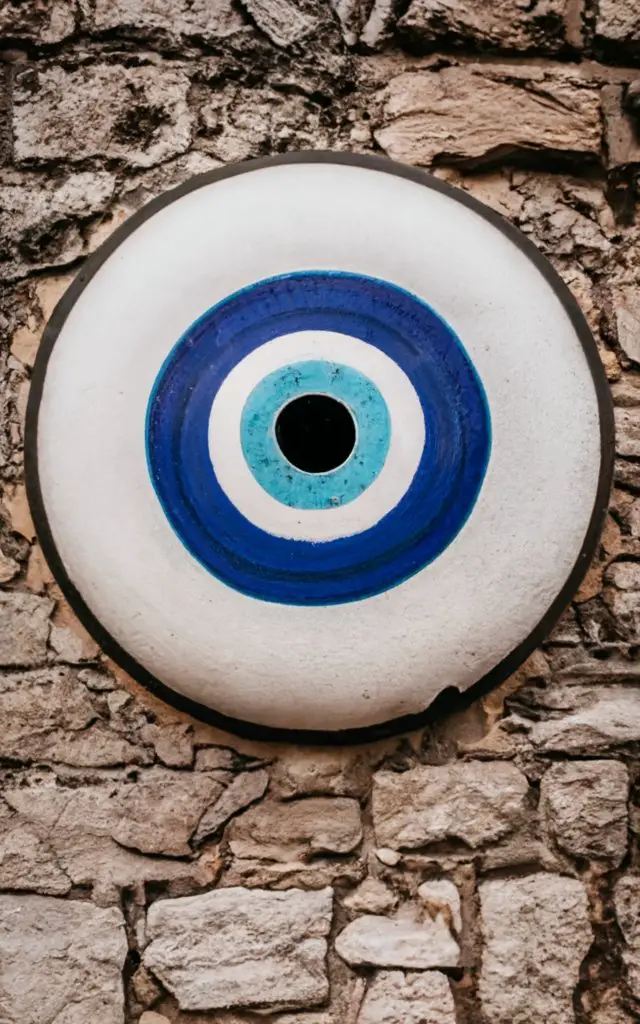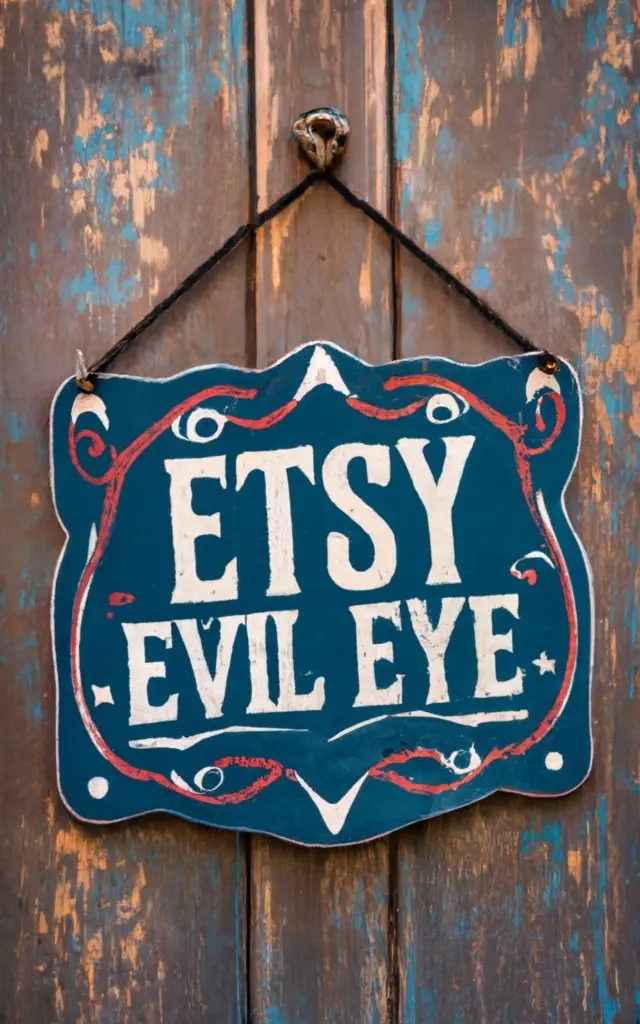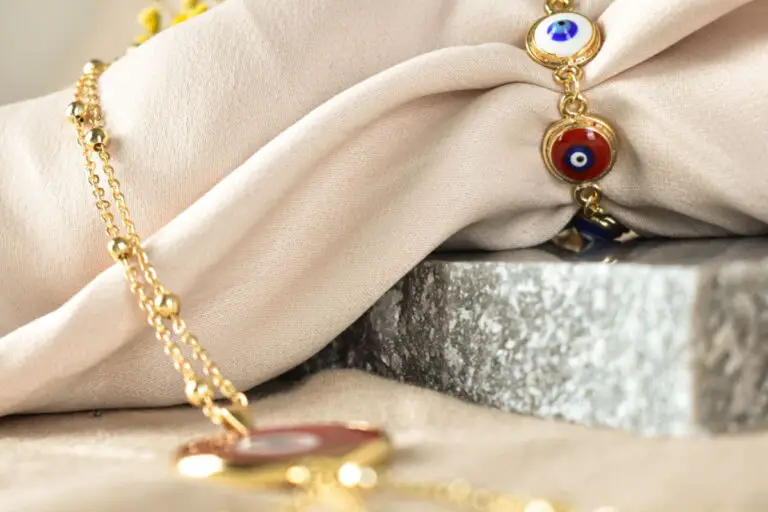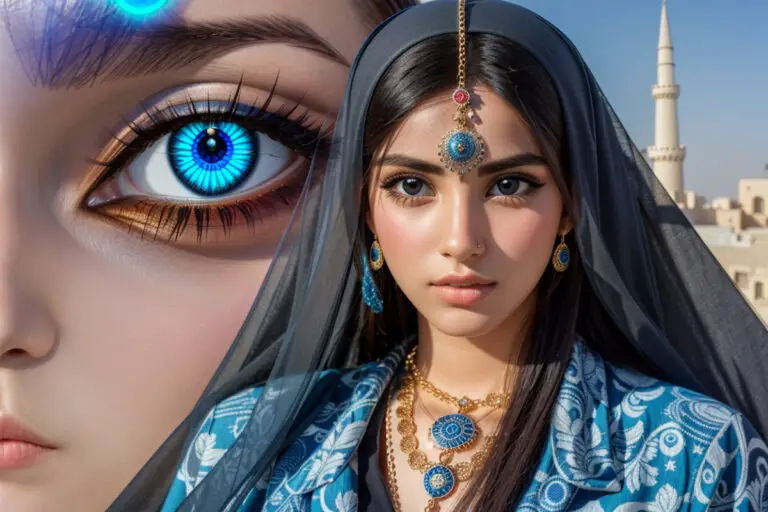Evil Eye Greek: Unraveling 11 Misunderstood Questions
Introduction
Evil Eye Greek The Evil Eye, with its profound cultural significance in Greece and across the Mediterranean, has long captivated our curiosity.
From the protective charms like the Nazar symbol and Mati belief to the centuries-old customs warding off the malevolent gaze, this enigmatic concept delves into history, beliefs, and superstitions, transcending borders to find a place in global folklore.
Explore the intricate world of the Evil Eye, its timeless traditions, and the ways it has influenced cultures worldwide.
If you’re eager to uncover even more about this fascinating topic, check out HobbyistGeek.com for an in-depth exploration of the Evil Eye and its enduring legacy.

What are the History and Origins of the Evil Eye in Ancient Greece?
The Evil Eye, with its enigmatic origins deeply rooted in the annals of ancient Greek culture, has fascinated scholars and believers alike for centuries. To understand its historical and cultural significance, we must delve into the rich tapestry of Greek traditions and superstitions that have shaped our understanding of this malevolent force. Ancient Greek traditions provide us with a lens through which we can examine the history and origins of the Evil Eye.
This belief in the destructive power of envy and jealousy finds expression in various forms throughout Greek mythology. From Medusa’s petrifying gaze to tales of gods inflicting misfortune upon mortals, the concept of an envious gaze causing harm is deeply ingrained in ancient Greek lore.
The symbolism of eye-shaped jewelry is another intriguing aspect that sheds light on the origins of this belief. Eye-shaped pendants, known as “mati,” are commonly worn as protective charms against the Evil Eye in Greece and other Mediterranean cultures.
These amulets serve as tangible reminders of the pervasive fear surrounding this maleficent force. As we explore further, it becomes evident that beliefs in warding off evil are not confined to Greece alone; they span across cultures worldwide.
The Nazar symbol prevalent in Turkish folklore bears a striking resemblance to the Evil Eye amulets found throughout Greece. This symbol represents a vigilant watch against malevolence, echoing similar beliefs around protection from harm.
In examining symptoms associated with being afflicted by this evil gaze, one discovers an amalgamation of folk beliefs prevalent in Greece. Symptoms such as unexplained illnesses, chronic misfortune, or inexplicable accidents are often attributed to the influence of the Evil Eye.
It is within these experiences that we find evidence supporting belief systems deeply embedded within Greek culture. To counteract these malevolent forces, various protective rituals and objects have been employed throughout history.
From using specific incantations to performing intricate ceremonies involving olive oil or water purification rituals – the ways to avoid the Evil Eye are as diverse as the beliefs themselves. These rituals serve not only to protect individuals but also to ensure the safeguarding of their homes, businesses, and loved ones.
Moreover, beauty’s association with the Evil Eye in ancient Greece adds a fascinating dimension to our understanding of this belief. In a society that glorified physical appearance and admired aesthetics, it is no surprise that beauty was believed to attract envy and subsequently become a target for malevolent gazes.
The notion that jealousy could cause harm underscores the delicate balance between admiration and caution prevalent in Greek society. It is important to note that religious influences have shaped the belief system surrounding the Evil Eye in Greece.
With Christianity’s arrival in Greece, elements of pagan traditions intermingled with Christian practices, resulting in a syncretic approach towards protecting oneself from this evil force. This fusion of beliefs highlights how deeply ingrained superstitions can be within cultural practices.
As we embark on this journey exploring Greek beliefs and superstitions surrounding the Evil Eye, we must recognize that its historical origins are intertwined with aspects ranging from envy and jealousy to beauty and religious influences. Unraveling these mysteries allows us to gain insight into the multifaceted nature of this age-old belief system while appreciating its enduring significance within Greek culture and beyond.
What is the Cultural Significance of the Evil Eye in Modern-day Greece?
In modern-day Greece, the cultural significance of the Evil Eye is deeply rooted in Greek superstitions and folk beliefs. The belief in the Evil Eye holds immense power and influence over daily life, as it is viewed as a force that can bring harm or misfortune to individuals and their loved ones.
The cultural significance of the Evil Eye can be observed in various aspects of Greek society, from everyday conversations to rituals and protective charms. Greek people firmly believe that envy, jealousy, and the envious gaze can cast the Evil Eye upon others.
This belief stems from ancient Greek traditions and has been passed down through generations. Many Greeks are cautious about praising someone too much or drawing attention to their achievements for fear of inadvertently inviting an envious glance.
To protect oneself from the malevolence of the Evil Eye, Greeks often turn to various rituals and practices. One prominent aspect is the use of amulets and protective charms known as “Mati.” These eye-shaped jewelry pieces are believed to ward off the Evil Eye by capturing its attention, thereby diverting its gaze away from individuals.
The cultural significance of the Evil Eye extends beyond Greece’s borders as well. In Mediterranean beliefs, similar concepts surrounding the envious gaze exist across different cultures.
For instance, in Turkey, it is known as “Nazar” symbolizing protection against evil forces. Similarly, in Middle Eastern countries like Lebanon and Egypt, there exists a strong belief in warding off evil with eye-shaped amulets.
The connection between beauty and protection against the Evil Eye is also noteworthy within Greek culture. It is believed that one can enhance their beauty by wearing specific charms or reciting protective prayers to avoid attracting envy or casting an evil glance upon oneself.
Overall, understanding the cultural significance of the Evil Eye provides valuable insights into Greek society’s deep-rooted beliefs and customs surrounding this age-old phenomenon. From protection rituals to various forms of amulets used for warding off the Evil Eye, this belief continues to shape daily life and interactions among Greeks, highlighting the enduring influence of ancient traditions within contemporary society.
What are the Beliefs and Superstitions Surrounding the Evil Eye in Greek Culture?
In Greek culture, the beliefs and superstitions surrounding the Evil Eye are deeply rooted and pervasive. Folk beliefs in Greece hold that the Evil Eye is a malevolent force capable of causing harm or misfortune to those who fall under its envious gaze. This belief is not limited to any specific social or economic class but permeates all levels of society.
Greek superstitions regarding the Evil Eye are often accompanied by various protective charms and rituals aimed at warding off its negative effects. Religious influences have also played a significant role in shaping these beliefs.
The influence of Christianity, combined with ancient Greek traditions, has created a complex tapestry of folklore surrounding the Evil Eye. One popular belief is that jealousy and envy can lead to the casting of the Evil Eye.
It is believed that when someone feels envy towards another person’s success, beauty, or happiness, their gaze can transmit negative energy that causes harm. The connection between beauty and the Evil Eye is particularly prominent in Greek culture.
The idea that excessive beauty can attract envy and subsequently provoke an envious gaze has led to intriguing customs such as wearing eye-shaped jewelry as protection against the Evil Eye. These adornments, known as “mati” in Greece, are often seen dangling from bracelets or necklaces and serve as tangible symbols of protection.
Recognizing symptoms of malevolence caused by the Evil Eye is another aspect deeply ingrained in Greek culture. People believe that sudden ailments, unexplained misfortunes, or persistent bad luck could be attributed to being under an envious gaze.
Such symptoms might include headaches, stomachaches, depression, sleep disturbances, or a general feeling of unease. To counteract these negative effects and ward off the Evil Eye’s influence, various amulets have been used throughout history by Greeks seeking protection from this malevolent force.
One widely recognized symbol employed for this purpose is known as “Nazar,” which resembles an eye-shaped charm. The Nazar symbol, seen in many Mediterranean beliefs, is believed to repel the envious gaze and safeguard against the Evil Eye’s ill effects.
In Greece, protection rituals and practices have been passed down through generations as a means of avoiding the Evil Eye. These rituals can include reciting prayers, performing specific gestures or actions, or using sacred objects for spiritual fortification.
The cultural significance of protecting oneself from the Evil Eye has remained deeply ingrained in Greek society for centuries. While beliefs surrounding the Evil Eye are prevalent in Greek culture, this belief system extends beyond its borders.
Similar notions exist worldwide, albeit with variations in symbolism and rituals. In countries such as Turkey, Italy, India, and Egypt, similar superstitions persist with their unique interpretations of warding off the envious gaze.
The roots of the belief in the Evil Eye can be traced back to ancient times. Historical origins suggest that this belief predates written records and was prevalent throughout various civilizations across the Mediterranean region.
Over time, these beliefs became intertwined with different religions and cultural practices but retained their essence as a powerful force capable of causing harm through envy. Greek beliefs surrounding the Evil Eye are deeply rooted in folklore and superstition.
With protective charms such as eye-shaped jewelry and rituals aimed at warding off its malevolent effects, Greeks have developed a rich tapestry of customs to combat this pervasive belief. Whether influenced by religious practices or historical origins dating back centuries ago, these traditions continue to hold cultural significance in Greece while also being part of beliefs shared across diverse societies worldwide that recognize the potential dangers associated with envy and jealousy.
What Different Words Are Used to Refer to the Evil Eye in the Greek Language?
In the Greek language, there are various words and phrases used to refer to the concept of the Evil Eye. One commonly used term is “Matiasma,” which directly translates to “the act of giving someone the Evil Eye.” This word captures the essence of the belief system surrounding the Evil Eye and its potential harm. Another term often encountered is “Baskania,” which refers to a spell or curse cast by an envious gaze.
This word specifically emphasizes the malevolent intention behind casting the Evil Eye. Furthermore, in some regions of Greece, people use the term “Vaskania” instead of “Baskania” to describe this harmful gaze.
The variation in pronunciation reflects regional linguistic nuances but holds a similar meaning. Additionally, words like “Mati” or “Nazar” are frequently used in colloquial Greek conversations when discussing protection against the Evil Eye.
These terms have their roots in Mediterranean beliefs and symbolize various protective talismans. The usage of multiple terms to describe different aspects of the Evil Eye showcases its pervasive presence within Greek culture.
Each word carries subtle connotations while encompassing a particular aspect of this ancient belief system. Understanding these variations provides insight into how deeply ingrained this notion is within Greek society and highlights its significance in daily life conversations.
From historical origins rooted in ancient Greek traditions to its cultural significance today, these linguistic variations convey a rich tapestry of folklore and superstition surrounding this age-old concept. The diversity of words used exemplifies how different aspects such as religious influences, envious gazes, protective charms, and beauty are woven together creating a complex web intertwining language with beliefs about warding off evil forces.
As we unravel more misunderstood questions about Evil Eye beliefs in Greece, exploring these linguistic variations offers us a glimpse into how deeply embedded this concept remains within their cultural fabric. It serves as a reminder that understanding such intricate details fosters appreciation for diverse belief systems and the fascinating ways in which they shape societies.
What are the Symptoms of Illness Caused by the Evil Eye in Greek Culture?
In Greek culture, the belief in the Evil Eye is deeply ingrained, and it is believed to cause various physical and psychological symptoms in its victims. These symptoms are seen as manifestations of the malevolence directed towards them through the envious gaze.
For instance, individuals who have fallen victim to the Evil Eye may experience unexplained headaches, dizziness, or a general feeling of malaise. This can be attributed to the negative energy that is believed to infiltrate their body as a result of someone casting an envious glance their way.
Moreover, anxiety and restlessness are commonly associated with being affected by the Evil Eye. The individual may suffer from sleep disturbances or experience a persistent sense of unease without any apparent cause.
It is said that these symptoms arise due to the intrusive thoughts and negative emotions that result from the malevolent influence of those who harbor envy or ill will. Interestingly, physical signs can also manifest when someone has been targeted by the Evil Eye.
Some people might notice a sudden change in their appearance; they may appear paler or more fatigued than usual. In extreme cases, it is even believed that one’s eyes may become bloodshot or exhibit unusual redness—a visual representation of the evil intent directed towards them.
These symptoms demonstrate how deeply rooted and widespread belief in the Evil Eye is within Greek culture. When faced with such afflictions, individuals often turn to protective rituals and talismans like amulets shaped like eyes—known as “mati” in Greece—to ward off any potential harm caused by this envious gaze.
These amulets serve as a shield against negativity and are worn as jewelry or placed in homes and workplaces for added protection. By understanding these symptoms associated with falling prey to the Evil Eye, we gain insight into how this ancient belief system has influenced Greek customs throughout history – from traditional practices rooted in ancient Greek traditions to modern-day superstitions aimed at protecting oneself from the malevolent power of the envious gaze.
How Can One Protect Themselves from the Evil Eye in Greek Culture?
In Greek culture, the belief in the Evil Eye runs deep, and protecting oneself from its malevolent gaze has become an integral part of everyday life. The ancient traditions that surround warding off the Evil Eye are as diverse as they are intriguing.
One of the most common methods employed is the use of protective charms and amulets. These can take various forms, such as an eye-shaped pendant or a small blue glass bead known as the Nazar symbol.
These talismans are believed to absorb or deflect the envious gazes that may be cast upon an individual. Another way to protect against the Evil Eye is through rituals and incantations.
Some Greek superstitions prescribe reciting prayers or invoking specific deities to shield oneself from its effects. For instance, invoking the name of Saint Basil or Saint Charalambos is said to provide a strong defense against this malevolent force.
Folk beliefs in Greece also suggest various practical measures to avoid attracting unwanted attention and ward off potential harm. It is believed that wearing bright and vibrant colors can create a diversion for the Evil Eye, as it becomes mesmerized by these captivating hues instead of focusing on one’s well-being.
Furthermore, being discreet about one’s achievements or possessions is seen as another means of protection against jealousy and envy, which are often cited as catalysts for casting the Evil Eye. This notion emphasizes humility and modesty in Greek society, where individuals strive to avoid arousing feelings of envy in others.
Additionally, certain rituals passed down through generations hold significance in averting any ill effects caused by the Evil Eye. One such ritual involves lightly spitting three times into your own reflection while crossing your fingers—an action believed to deceive evil forces into believing you are unharmed.
While these practices may seem peculiar from an outsider’s perspective, they highlight not only the deeply rooted cultural significance of warding off the Evil Eye but also reinforce communal bonds within Greek society. The belief is so prevalent that it permeates daily life and influences the choices individuals make, transforming the rituals into a way of preserving their well-being and protecting themselves from any potential harm.
What is the Role of Envy and Jealousy in the Casting of the Evil Eye in Greek Culture?
Envy and jealousy play a crucial role in the casting of the Evil Eye within Greek culture. These emotions are believed to be the driving force behind the malevolent gaze that can bring harm or misfortune to others. Greek superstitions hold that individuals who possess strong feelings of envy or jealousy have the power to unleash the Evil Eye, often unintentionally, through their intense glare.
It is believed that these negative emotions create an energy that is transferred from one person to another, resulting in the curse of the Evil Eye. Within Greek society, envy and jealousy have long been recognized as potent forces capable of causing harm.
The cultural significance placed on these emotions stems from their potential to disrupt harmony and create discord among individuals. This belief reflects a deep understanding of human nature and acknowledges that envy and jealousy can arise naturally within social interactions.
The concept of envy and its connection to the casting of the Evil Eye extends beyond Greece and is found in various Mediterranean beliefs as well. Similar folklore exists in neighboring countries where this phenomenon is attributed to a person’s envious gaze rather than any supernatural power.
The evil eye belief is deeply ingrained within Mediterranean cultures, serving as a cautionary tale against harboring harmful emotions towards others. To protect oneself from falling victim to an envious gaze, diverse protection rituals have been developed throughout history.
In ancient Greece, individuals seeking safeguards against the Evil Eye would often wear amulets or charms featuring eye-shaped symbols known as “mati.” These symbols were believed to ward off evil spirits by reflecting back their malevolence. The association between beauty and the Evil Eye holds particular significance in ancient Greek traditions.
It was widely believed that those who possessed exceptional beauty were at greater risk of attracting jealous gazes, making them vulnerable targets for potential curses. To counteract this danger, individuals adorned themselves with eye-shaped jewelry or incorporated protective charms into their daily lives.
Across various cultures worldwide, belief systems surrounding the Evil Eye have merged with different religions and folk traditions, resulting in unique interpretations and protective practices. One such example is the Nazar symbol, a popular protective amulet in Turkish and Middle Eastern cultures.
The Nazar, often depicted as a blue eye, is believed to ward off the Evil Eye by deflecting its negative energy. Envy and jealousy hold significant roles within Greek culture when it comes to casting the Evil Eye.
These emotions are seen as catalysts for harm, with their intense glare believed to possess the power to bring misfortune upon others. This cultural belief reflects an understanding of human nature and emphasizes the importance of maintaining harmonious relationships.
Through various protection rituals such as wearing amulets or charms featuring eye-shaped symbols, individuals aim to safeguard themselves against the malevolent effects of envy and jealousy. The Evil Eye belief extends beyond Greece’s borders, resonating throughout Mediterranean cultures and influencing diverse interpretations worldwide.
How is the Belief in the Evil Eye Present in Other Cultures Around the World?
Belief in the evil eye is not limited to Greek culture; it permeates various societies around the world, albeit with slight variations in interpretation and practices. One such example is the Nazar symbol commonly found in Middle Eastern and North African cultures. This blue-colored eye-shaped amulet, often seen dangling from a necklace or adorning household items, serves as a protective charm against the envious gaze.
In Turkey, they have their own version of the evil eye called “Mati,” which holds great cultural significance. The Mati belief shares similarities with Greek superstitions regarding its origins and protective measures.
It is believed that wearing eye-shaped jewelry or having Nazar amulets can shield individuals from the malicious intentions of others. Moving to South Asia, countries like India also embrace the concept of the evil eye.
They refer to it as “Buri Nazar,” a term derived from Hindi and Urdu languages. Here, people believe that certain individuals possess unintentional malevolence due to their jealousy or envy.
To guard against this harmful energy, they use various protective charms and perform rituals such as burning herbs or incense to cleanse their living spaces. Even though these beliefs diverge across different cultures, religious influences often play a significant role in shaping them.
For instance, in Christian communities in Mediterranean regions like Italy and Spain, one can find references to warding off the evil eye through prayers or invoking divine intervention. The universality of human emotions like jealousy and envy contributes to the widespread acceptance of evil eye beliefs worldwide.
It serves as a cautionary reminder that even seemingly innocent acts can inadvertently cause harm to others through negative thoughts or intentions. While each culture may have its unique ways of dealing with this malevolent force, it remains intriguing how ancient traditions intertwine with modern practices regarding beauty standards and protection against potential harm caused by casting an envious gaze upon others – an idea that has persisted throughout history across continents and civilizations.
How are Amulets and Talismans Used to Ward off the Evil Eye in Greek Culture?
In Greek culture, the belief in the Evil Eye runs deep, and as a result, various methods have been developed to protect oneself from its malevolent effects. One prevalent and widely used method is the use of amulets and talismans. These objects are believed to possess innate protective powers, capable of warding off the Evil Eye and preserving one’s well-being.
Evil Eye amulets come in various forms, but perhaps the most common is eye-shaped jewelry known as “mati” or “nazar.” The eye symbolizes vigilance against evil forces and acts as a talismanic object that has been in use for centuries across different Mediterranean beliefs. The concept of using eye-shaped charms can even be traced back to ancient Greek traditions, where it was believed that these symbols could repel any envious gaze or ill-intent directed towards an individual.
Religious influences have also played a significant role in shaping the use of amulets against the Evil Eye. In Greece, Orthodox Christianity coexists with ancient folk beliefs, resulting in a unique amalgamation of practices.
Many people seek blessings from religious figures such as priests or monks who perform rituals to infuse these amulets with divine protection. This blending of cultural significance attests to how deeply rooted the belief in warding off the Evil Eye is within Greek superstitions.
Beyond religious rituals, there are also personal ways individuals can employ protective charms against this malevolent force. These include wearing bracelets or necklaces adorned with blue beads or small replicas of eyes made from precious metals like silver or gold.
It is widely believed that these materials possess inherent qualities that counteract negative energy and preserve one’s well-being. It’s important to note that while these amulets serve as tangible objects for protection against the Evil Eye, they are not merely decorative pieces but hold great significance within Greek culture.
They act as visual reminders for individuals to stay vigilant and protect themselves from the effects of envy and jealousy. The use of amulets and talismans is deeply ingrained in Greek society, serving as a powerful tool to combat the perceived dangers associated with the Evil Eye.
The use of amulets and talismans to ward off the Evil Eye in Greek culture reflects a rich history of beliefs and superstitions. These protective charms, whether in the form of eye-shaped jewelry or other symbolic objects, hold deep cultural significance for Greeks.
They are not merely decorative ornaments but serve as tangible reminders to stay vigilant against envy and jealousy. Whether rooted in ancient Greek traditions or influenced by religious practices, these amulets play an integral role in safeguarding individuals from the harmful effects believed to be caused by the Evil Eye.
What is the Connection Between the Evil Eye and Beauty in Ancient Greece?
In ancient Greece, there existed a fascinating connection between the evil eye and beauty that permeated their beliefs and traditions. The Greeks believed that beautiful individuals were particularly susceptible to the malevolence of the evil eye. This connection stemmed from the notion that envy and jealousy often arose when others witnessed someone’s extraordinary beauty or good fortune.
It was believed that these intense emotions could manifest in an envious gaze, casting a curse upon the unsuspecting recipient. Consequently, individuals possessing exceptional physical attractiveness would adorn themselves with various protective charms to ward off the potential harm caused by this envious gaze.
Eye-shaped jewelry, known as “mati” in Greek, played a significant role in this belief system surrounding beauty and the evil eye. These talismans typically featured an eye symbol, resembling an exaggerated version of a real human eye.
The purpose of wearing such jewelry was twofold: Firstly, it acted as a deterrent to those who might cast an envious or malicious gaze; secondly, it was seen as a symbolic representation of protection against any potential harm caused by the evil eye itself. This belief in the connection between beauty and the evil eye wasn’t limited to ancient Greece alone; it reverberated throughout different cultures worldwide.
The Nazar symbol, popularly used in Turkish and Middle Eastern cultures as a charm against the evil eye, also featured an intricately designed blue-eyed amulet resembling an open palm. This charm was believed to have originated from ancient Greek traditions but was adopted by other civilizations with their own unique interpretations over time.
Religious influences further shaped this belief system around beauty and its association with the evil eye. In predominantly Christian regions influenced by Byzantine traditions or Orthodox Christianity, prayers and rituals were employed as essential elements of protection against malevolent forces like envy or jealousy.
These rituals often involved holy water sprinkling or reciting specific incantations to dispel any negative energy surrounding individuals blessed with exceptional beauty. Despite variations in specific customs, the overarching theme of warding off the evil eye through protective rituals and charms remained remarkably consistent across time and geography.
The folk beliefs surrounding the connection between beauty and the evil eye continue to be deeply ingrained in Greek culture today. Whether it be wearing amulets or practicing certain protection rituals, many Greeks still hold firmly to these beliefs as a way to safeguard themselves against any potential harm caused by envy or jealous gazes.
Ancient Greek beliefs regarding the evil eye encompassed a profound connection with beauty. The perception that exceptional physical attractiveness could attract envy and jealousy from others led to a strong belief in the power of the envious gaze to cause harm.
Eye-shaped jewelry, protective charms, religious influences, and various protection rituals all played crucial roles in guarding against this malevolent force. These traditions not only shaped Greek culture but also influenced similar beliefs worldwide, demonstrating the enduring significance of this fascinating connection between beauty and the evil eye throughout history.
How Has the Belief System Around the Evil Eye Merged with Different Religions in the Mediterranean Region?
Throughout history, the belief in the Evil Eye has intertwined with various religions in the Mediterranean region, blending ancient Greek traditions and local folklore with religious influences. The roots of this fusion can be traced back to the Hellenistic period when Greek culture spread across different territories.
As these beliefs encountered other faiths, such as Christianity and Islam, they adapted and merged to create a unique tapestry of beliefs surrounding the Evil Eye. In Greece, for example, where cultural significance is deeply ingrained, the Evil Eye belief has been influenced by both Orthodox Christianity and ancient Greek traditions.
The Mati belief, a popular superstition in Greece associated with warding off the Evil Eye, has assimilated elements from both religious practices. To protect against this malevolent gaze, individuals often display eye-shaped charms or amulets called “Mati,” which are believed to bring good luck and provide a shield against envy and jealousy.
Similarly, in other Mediterranean countries like Turkey and Egypt, ancient beliefs have intertwined with Islamic customs. In Turkish culture, for instance, the Nazar symbol—an eye-shaped talisman—holds great significance as a protective charm against evil forces.
This symbol has become a prevalent motif in jewelry designs across various cultures. The fusion of different religions with local folk beliefs surrounding the Evil Eye is not limited to one region but extends worldwide.
In Latin American countries like Mexico and Brazil, for instance, there are similar folk beliefs centered around envious gazes causing harm. Amulets shaped like eyes or hands are commonly used to deflect these negative energies.
This diverse amalgamation of religious influences and cultural customs showcases how deeply rooted and widespread the belief in the Evil Eye truly is. It demonstrates that regardless of specific religious affiliations or geographical boundaries, people across time and space have sought protection against this perceived malevolence through a variety of symbolic rituals and charms.
As we immerse ourselves in understanding these interconnected belief systems surrounding the Evil Eye, we gain insight into the resilience of ancient traditions and the enduring power of cultural folklore. It is a testament to the shared human experience and our innate desire to protect ourselves from perceived threats, be they physical or metaphysical.
Conclusion for Evil Eye Greek
The belief in the Evil Eye has deep historical origins in Ancient Greek traditions and continues to hold significant cultural significance in modern Greece. The Evil Eye, also known as “Mati” in Greek, is believed to possess malevolent powers that can cause harm and misfortune to individuals who fall victim to its envious gaze.
The symptoms of malevolence caused by the Evil Eye range from physical ailments to financial troubles and relationship issues. To protect themselves from this malevolent force, Greeks have developed various protection rituals and traditions over time.
These include the use of Nazar symbols, Evil Eye amulets, and eye-shaped jewelry as protective charms against the envious gaze. The belief in the Evil Eye extends beyond Greece, with similar beliefs present in various cultures around the Mediterranean region and worldwide.
This indicates its universal appeal and enduring influence on folk beliefs. While historically tied to pagan practices, religious influences have merged with these beliefs over time.
Despite its association with negativity and danger, there is a certain beauty associated with the Evil Eye as well. In ancient Greece, it was believed that those who possessed exceptional beauty were more susceptible to its effects.
Although superstitions surrounding the Evil Eye may seem irrational to some, they serve as a window into cultural practices and belief systems that have been passed down through generations. It is a testament to human nature’s inclination towards finding explanations for life’s uncertainties.
While we may not all subscribe to these beliefs today, understanding their origins fosters empathy towards different cultures. In our interconnected world where diverse cultures coexist, it becomes essential to appreciate these age-old customs without dismissing them outrightly.
The widespread presence of warding off evil eye practices globally demonstrates humanity’s shared desire for protection against malevolent forces. So let us embrace these cultural nuances with an open mind while cherishing our own unique customs—a reminder that even amidst tales of darkness lie stories of resilience and hope—a sentiment that unites us all.
Frequently Asked Questions
- What is the Evil Eye in Greek culture, and what does it symbolize? Answer: The Evil Eye in Greek culture, known as “Mati” (μάτι), is a belief in malevolent glares that can bring misfortune or harm. It symbolizes the negative energy that can result from envy or jealousy.
- How can I protect myself from the Evil Eye in Greek tradition? Answer: You can protect yourself from the Evil Eye by wearing protective charms, such as the nazar or mati symbol, or using amulets and talismans. Other protective measures include avoiding excessive praise and practicing humility.
- Are there specific symptoms associated with the Evil Eye’s influence? Answer: Some common symptoms believed to be associated with the Evil Eye include unexplained illnesses, headaches, fatigue, and a string of bad luck. These symptoms are thought to result from the malevolent influence of the Evil Eye.
- What is the historical significance of the Evil Eye in ancient Greece? Answer: The belief in the Evil Eye has ancient roots in Greece, serving as a way to explain misfortune and illness. It was often linked to envy and jealousy and was a common superstition in ancient Greek culture.
- Do other cultures in the Mediterranean region share similar beliefs in the Evil Eye? Answer: Yes, belief in the Evil Eye is not unique to Greek culture. Many cultures in the Mediterranean region, the Middle East, and parts of Latin America hold similar beliefs, each with its variations and protective rituals.
Unlock the Power of Evil Eye Protection!
Hobbyist Geek. Com
Explore HobbyistGeek.com today, where I’ve curated a wealth of articles covering everything you need to know about the Evil Eye.
Discover recommended materials, learn proper rituals, delve into color symbolism, and even find in-depth reviews of specific Evil Eye products to aid you in choosing the perfect one.
Strengthen your protection against the Evil Eye by visiting www.HobbyistGeek.com.
Don’t forget to sign up for our email list to stay updated with exclusive insights and offers.
Feel free to drop any questions you may have below – I’m here to guide your spiritual journey.
If you enjoyed this informative article I know you will love:
Is The Evil Eye Good Or Bad?: Explained
Evil Eye Bracelet Color Meaning: How Colors Influence Your Life!
Check out more information on Evil Eye!
- Evil Eye Hand: Unveiling the Mystical Origins and Meanings - February 2, 2024
- Amegreen Amethyst Meaning: Discover the Hidden Magic! - February 2, 2024
- Is The Evil Eye Bad?: A Deep Dive into Evil Eye Taboos - February 2, 2024









